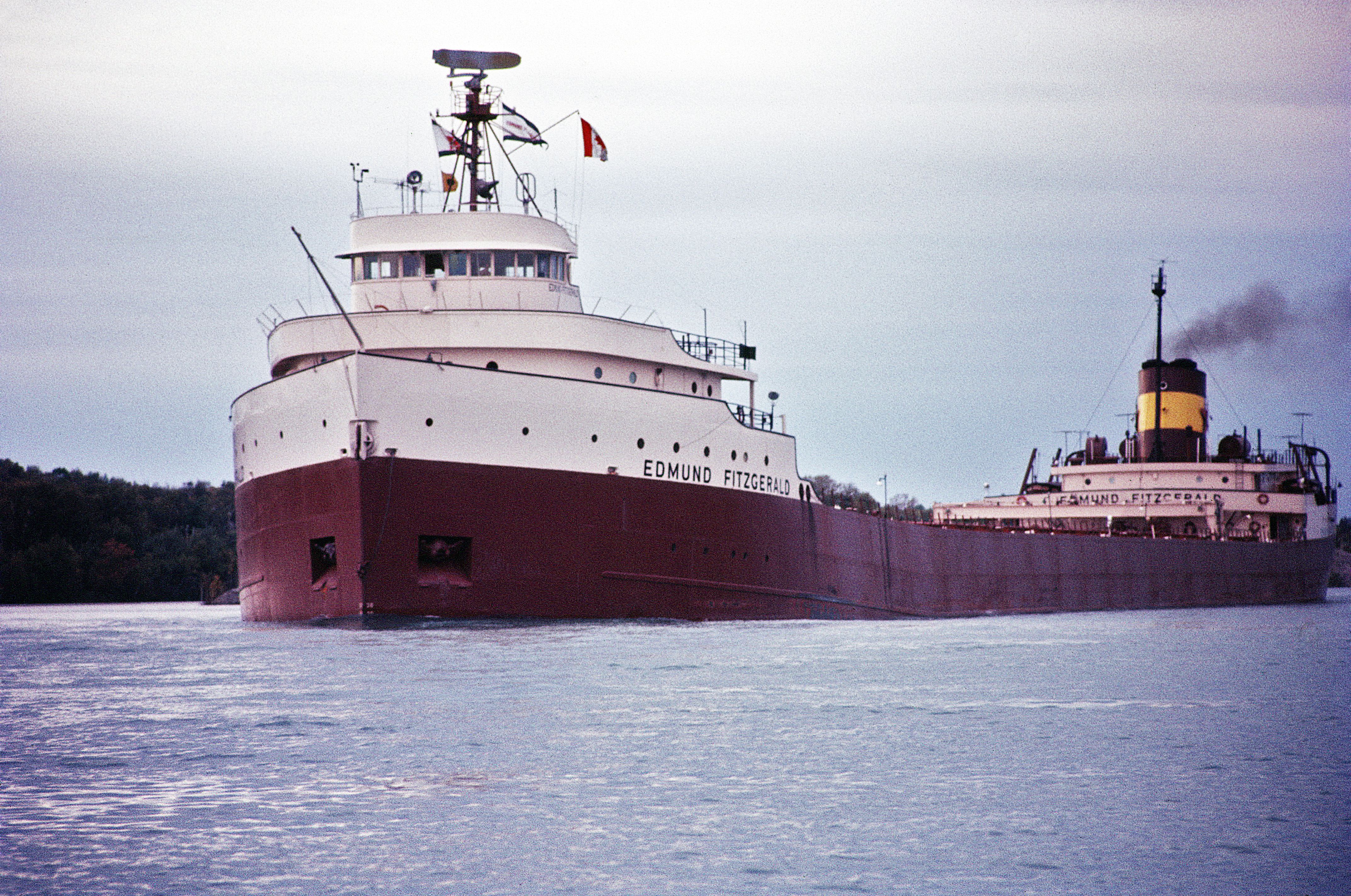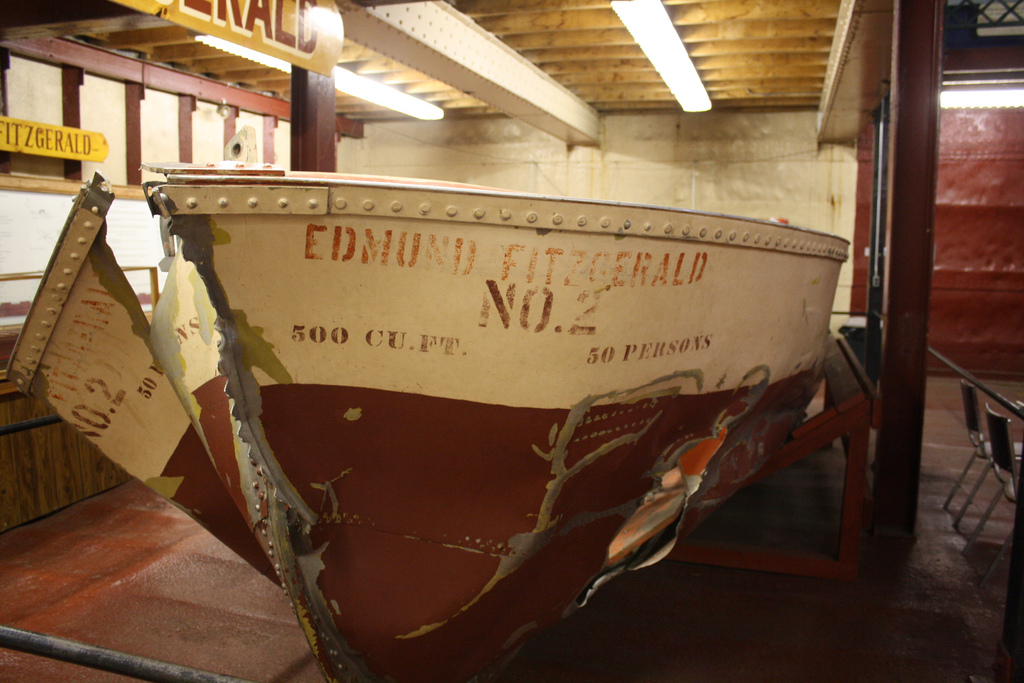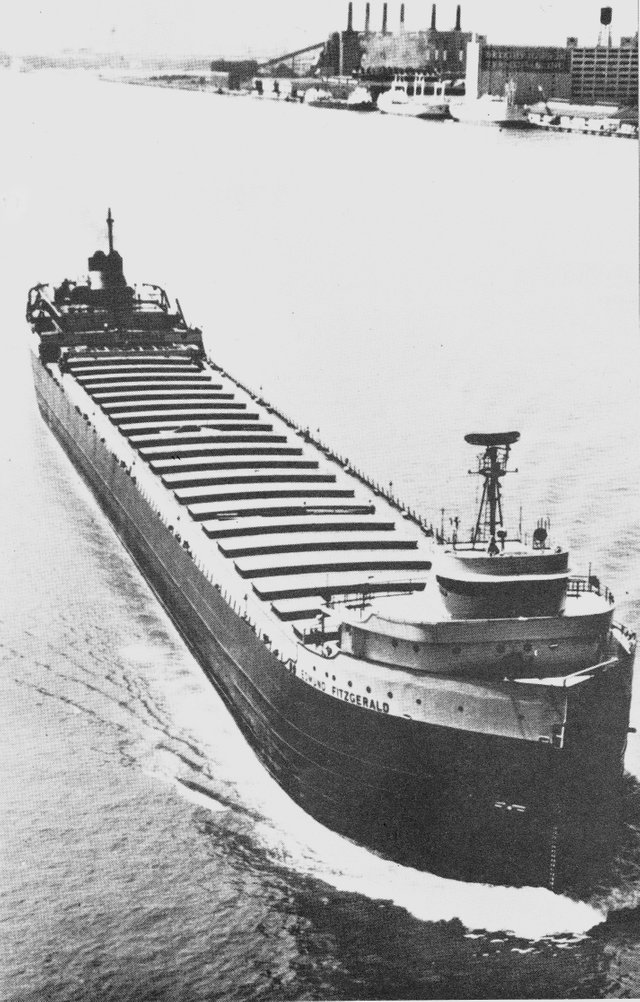The Wreck Of The Edmund Fitzgerald
 The "Big Fitz"
The "Big Fitz"When people think of shipwrecks, names like Titanic and Andrea Doria often come to mind. Not many people know, however, that there have been many shipwrecks that happened in fresh waters. The Great Lakes, a series of five interconnected freshwater lakes located in the upper mid-east region of North America, on the Canada–United States border, are the final resting places of some 6000-8000 ships. Even more haunting than that, it's estimated that the Great Lakes are the final resting place of some 30,000 souls.
About The SS Edmund Fitzgerald
One of the most notable and famous ships that went down on the Lakes is the Steam Ship (SS) Edmund Fitzgerald.
The Fitzgerald, affectionately referred to by her crew as "Big Fitz" carried iron ore pellets, called taconite, from mines near Duluth, Minnesota to ironworks facilities in Toledo, Detroit, and other ports on the Great Lakes.
The Edmund Fitzgerald, originally named "Hull 301" for building purposes, was commissioned by the Northwestern Mutual Life Insurance Company of Milwaukee, Wisconsin. In August 1957, the Great Lakes Engineering Works (GLEW), of River Rouge, Michigan, began to build the ship. The ship was named after the president and chairman of the board of Northwestern Mutual, whose grandfather had actually been a captain on the lakes.
At the time of its launch on June 7, 1958, the Fitzgerald was the biggest ship on the Great Lakes, at 729 feet (222 m) long, 75 feet (22.9 m) wide. The vertical height of the hold was 39 ft (12 m). It's important to note that The Edmund Fitzgerald's hull was just one foot short of the maximum 730 ft limit for St. Lawrence Seaway ships at that time. She sported coal-fired boilers (later upgraded to oil burners in 1971-1972) and had an amazing cargo hold size of 26,000 tons.
The ship was said to be quite luxurious by steamship standards, with above average cuisine and air-conditioned crew quarters that had more amenities than most other ships of her standard. Simply put, it was a beautiful ship and I would imagine one that any mariner would consider himself lucky to be assigned to.
The ship was officially launched on June 7, 1958, in front of a crowd of 15,000 spectators. Some people thought the ship was bound for misfortune, however, due to several events that would be considered very bad signs by sailors and those involved in the maritime industry.
Edmund Fitzgerald's wife, Elizabeth, was tasked with "christening" the ship, which involves smashing a bottle of champagne across the bow. This took three tries, which was quite a bad omen. Even more disastrous was the actual launch of the ship. It took shipyard crew members thirty-six minutes to release the keel blocks, and when the ship finally did launch, it slipped out sideways and created a huge wave that drenched the spectators. It then proceeded to slam hard into a pier before finally righting itself. Witnesses later said they thought the ship was "trying to climb right out of the water." Finally, and this is the worst part, the havoc caused one of the spectators to have a heart attack, from which he later died.
These rumors were all dispelled shortly after the Fitzgerald started to do its job, as it performed magnificently and proceeded to set and break many of its own records over a 17 year period leading up to November 1975.
 Taconite Pellets similar to what the Edmund Fitzgerald hauled
Taconite Pellets similar to what the Edmund Fitzgerald hauledThe Wreck Of The Edmund Fitzgerald
The Edmund Fitzgerald left Superior, Wisconsin around 2:00 in the afternoon on November 9, 1975. She was loaded full of around 26,000 tons of taconite pellets. Her destination- A steel mill on Zug Island, near Detroit, Michigan.
The National Weather Service had predicted a storm would pass just south of Lake Superior in the early morning hours of November 10, but this was not out of the ordinary for that time of year.
The Fitzgerald wasn't going to be traveling alone. She was joined by a second freighter, the Arthur M. Anderson, roughly 3 hours into her voyage. The Fitzgerald, captained by Ernest McSorley, began sailing behind the Anderson, but would eventually pull ahead and become the lead ship.
At 7 pm, the National Weather Service amended its initial forecast and issued gale warnings for the whole of Lake Superior. This announcement caused McSorley and Anderson captain Bernie Cooper to alter their route and seek shelter along the Ontario coast.
They encountered the beginning of a severe winter storm around 1 am, and conditions worsened throughout the morning. Winds as high as 52 knots (60 mph) and waves as high as 10 feet were reported.
Captain Cooper and Captain McSorley were in radio contact with each other throughout the morning and into the afternoon on November 10. Shortly after 3:30 pm on Saturday afternoon, McSorley reported that the Fitzgerald was taking on water and had developed a list. He also stated that the ship had lost 2 hatch covers and a fence railing. McSorley also told Captain Bernie Cooper that he had lost all radar.
The last communication came from the ship at 7:10 pm, when McSorley told the Anderson, "We are holding our own." It's thought that the ship went down within minutes of that final radio transmission.
 A lifeboat recovered from the Edmund Fitzgerald
A lifeboat recovered from the Edmund FitzgeraldWhy Did It Sink?
There are several theories about why the ship sank. The fact is, though, nobody really knows exactly what happened.
The official Coast Guard report stated that it was most likely due to ineffective hatch closures. The Fitzgerald had 21 hatches that were used to load her hold. Each hatch had a very heavy cover that was secured with a number of clamps. As this was a job that was performed by the crew, the Coast Guard's theory was not very popular, as it suggested that the crew may not have secured these hatches properly. If one or more of these hatches dislodged during the voyage, the cargo hold would have most likely flooded.
Other theories suggested a series of rogue waves may have overturned the ship. It was also thought that because the Fitzgerald altered her course to hug the shoreline in an attempt to gain shelter from heavy winds, that the ship may have run aground at some point, causing a significant hull rupture.
Other possibilities include basic structural failure and even a collision with a large piece of floating debris. The bottom line is that the only people who know what really happened are the 29 brave souls who went down with the great Edmund Fitzgerald.
 Full length top view of the Edmund Fitzgerald (note hatches)
Full length top view of the Edmund Fitzgerald (note hatches)Immortalization By Gordon Lightfoot
I actually learned about the Edmund Fitzgerald when perusing YouTube one afternoon. A "recommended video" appeared in the sidebar called "The Wreck of The Edmund Fitzgerald." Interested as I am in all things nautical, I clicked on it and discovered a truly amazing song.
The song was written, composed, and recorded in 1976 by folk singer Gordon Lightfoot for his "Summertime Dream" album. I had to listen to the song several times to truly get the full experience. All I can say is even if you don't like this kind of music, I guarantee you will enjoy this song.
Documentary
There are quite a few documentaries available on YouTube. This is the one I would recommend.
Crew Tribute
Here are the names of the 29 brave men who went down with the Edmund Fitzgerald on November 10, 1975.
FREDERICK BEETCHER
THOMAS BENTSEN
EDWARD BINDON
THOMAS BORGESON
OLIVER CHAMPEAU
NOLAN CHURCH
RANSOM CUNDY
THOMAS EDWARDS
RUSSELL HASKELL
GEORGE HOLL
BRUCE HUDSON
ALLEN KALMON
GORDON MACLELLAN
JOSEPH MAZES
JOHN MCCARTHY
ERNEST MCSORLEY
EUGENE O'BRIEN
KARL PECKOL
JOHN POVIACH
JAMES PRATT
ROBERT RAFFERTY
PAUL RIIPPA
JOHN SIMMONS
WILLIAM SPENGLER
MARK THOMAS
RALPH WALTON
DAVID WEISS
BLAINE WILHELM
I would also like to include a link to the Edmund Fitzgerald website. There is a lot more information about the ship and crew there. Please take the time to visit. I'm sure that like me, you will be captivated by this incredible story.
Edmund Fitzgerald Website: www.ssedmundfitzgerald.org

good post
I loved Gordon Lightfoot songs when I was younger. The one mentioned above and Whispers of the North, just to mention a few. :)
Your post resteemed and upvoted by @yusifm
From the viewpoint of someone who got Canadian schooling but still heard the song, it's a story that ought to be addressed as part of the history classes in the US. Maritime economy has been a relatively large part of the east coast life for way too many years to ignore. Of course, I don't know if they do cover it, just that I've never seen much reference to all the traffic on the lakes and St. Laurence Seaway in US books. We covered some of importance of the Seaway in Canada but the lakes aren't Canadian.
I saw this post because you recommended I stop by and review your "other content". While I agree it is a great post and well composed, I likely wouldn't have clicked on it or taken the time to read it. It's just not a subject that I am that interested in.
Again welcome back. My comment is not meant to be negative feedback, it is just information on why I would or wouldn't have looked at it.
If you don't have followers (and active ones) it is unlikely to get discovered.
Really good article, Chris. It's hard to believe they really do not know exactly what happened to this Ship and how it sank. Interesting that it happened at 2 pm.
Read. Broke 6 comments! 😉
Nice post, I learnt something